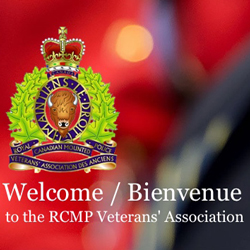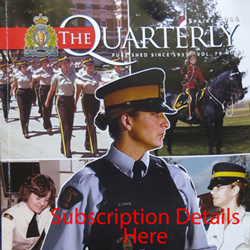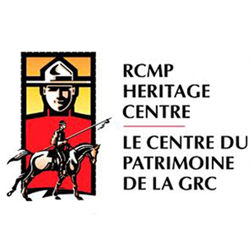The Royal Military College (RMC) & North West Mounted Police (NWMP)
The Royal Military College (RMC)
&
North West Mounted Police (NWMP)


Going back in time to the creation of the North West Mounted Police there is a clear connection between the NWMP and RMC. RMC was established in 1874 by, an Act passed by the Dominion Government of The Honourable Alexander Mackenzie to establish a Military College “for the purpose of imparting a complete education in all branches of military tactics, fortification, engineering and general scientific knowledge in subjects connected with and necessary to a thorough knowledge of the military profession”. Government emphasis was placed on nation building by the graduates, trained as engineers, in an attempt to defuse political opposition to the concept of a Military College. At the same time the NWMP was gathering together for the “Great March West”
RMC welcomed its first group of cadets, known ever since as the “Old Eighteen”, June 1, 1876,and received permission from Queen Victoria to call itself the Royal Military College of Canada (RMC) in 1878.
Putting a historical perspective on the first class of RMC, the Battle of Little Big Horn took place the same month and Robert McCutcheon, (Reg # 458) joined the NWMP. In March of 1877 McCutcheon was a member of the patrol headed by Superintendent James Morrow Walsh (O.109- JWC*) to meet Sitting Bull when he crossed the boundary line entering Canada. Robert McCutheon, was leading the patrol and was the first member of the NWMP to come into contact with Sitting Bull.
The connecting dots between the then Military College and the NWMP begins with the first classto attend, the “Old Eighteen”. One of the members of that first class was Aylesworth Bowen Perry, (NWMP – O.44 – JWC*), who later became the 6th and longest serving Commissioner of the Force.
He was student #13, one of the “Old Eighteen.” Since cadets received their numbers based on their standings in the entrance examinations, he was 13 of 18. At the age of fifteen, he was one of the youngest students at RMC. He graduated at the top of his class receiving the Governor-General’s gold and silver medals.

In 1948, he was the only member of the “Old Eighteen” to be present at the re-opening of the Royal Military College of Canada after WW II and he took the salute for the march past of the “New Hundred”.
Over the years two other graduates of RMC served as Commissioners of the Force, Stuart Taylor Wood, (Officer # O.171 – JWC*), [his father was Ass’t Commissioner Zachary Taylor Wood (Officer # O.54 – JWC*), was also a graduate of RMC] and George B. McLellan (Reg # 11757/O.314).
Another notable member of the NWMP – RNWMP who had a connection to RMC was Superintendent Archibald Cameron MacDonell, (Officer # O.95 – JWC*), who later became the Commandant of RMC.
*JWC – Joined with Commission
There have been many who graduated from RMC who have had career changes and left the military and joined the Force. Thus, begins the story of one of those early RMC cadets who was drummed out of RMC and ended up joining the NWMP, albeit for a very short career.
Vincent Henry Robert “Bobby” Biscoe, (Reg # 3397), was born May 10th, 1880, in Bengal,India, according to Archives Canada records. After he left RMC, where he was known as “Robert the Devil”, he joined the NWMP at Regina, March 20th, 1899, as a Special Constable, for a probationary two-month period. He re-engaged for one month of probationary service, May 20th, 1899. He again, re-engaged for five years, May 1st, 1899.

During his time in the NWMP Biscoe had some run-ins with those from on high:
July 14th, 1899, Superintendent Sanders fined Biscoe $1.00 “for leaving a cell door open”.
August 14th, 1899, Superintendent Sanders once again levied another $1.00 fine to Biscoe “for being inattentive on a prisoner escort”.
A $1.00 fine by today’s standards would seem laughable, but when you were only making a dollar a day that would be a pretty big blow on pay day…whenever it occurred!
Biscoe volunteered to join the Canadian Mounted Rifles, made up of NWMP members, for the South African War.
He never returned to the NWMP and was Struck Off Strength, November 15th, 1900.
Robert Biscoe passed away Dec 19th, 1959 at Saanich, BC, he was 79 years of age.
There is much more to the story of Bobby Biscoe.
Below is a story sent to me by a former RMC graduate, written in 1991 by the Curator of the RMC Museum. Some of Bobby Briscoe’s time at RMC was detailed on another RMC cadet’s T-Square. I believe this would be akin to a RCMP recruit writing his troop’s history on one of those boards passed down from troop to troop used to shine their Sam Brownes on.
You have to appreciate trying decipher notes written on a T-Square 100 years ago would be difficult and the language of the day may confuse us in 2021.
I have also added a few additional bits of information in red to the story for clarification.
Ric Hall 24394/O.1330
The Tale of the T-Square or The Little Black Sheep of RMC
by Ross McKenzie, Curator, RMC Museum
We’re poor little lambs who’ve lost our way, Baa! Baa! Baa!
We’re little black sheep who’ve gone astray, Baa! Baa! Baa!
Gentlemen-rankers out on the spree,
Damned from here to Eternity,
God ha’ mercy on such as we,
Baa! Yah! Bah!
Gentlemen-Rankers by Rudyard Kipling
What is a Gentleman Ranker? He is an enlisted soldier who may have been a former officer or gentleman qualified through education and background to be a commissioned officer. It suggests that the signer was born to wealth and privilege but disgraced himself and so has enlisted as a common soldier (perhaps at the lowest rank, as a private or corporal) serving far from the society that now scorns him. Compare to remittance man, often the black sheep of a “good” family, paid a regular allowance to stay abroad, far from home, where he cannot embarrass the family.
The term also describes those soldiers who signed on specifically as ‘gentleman volunteers’ in the British Army to serve as private soldiers with the understanding being that they would be given a commission (without purchase) at a later date. The men trained and fought as private soldiers but “messed” (dined and perhaps socialized) with the officers and were thus afforded a social standing of somewhere in between the two.
A new [at the time of writing, i.e., 1991] acquisition by the RMC Museum has given us an intriguing glimpse at the College’s past. During recent renovations of an old Kingston home a somewhat battered wooden T-Square came to light and, as it was clearly marked as having belonged to, “Gent Cadet Albert A. Vernon, RMC 97-99”, the renovators thoughtfully passed it on to the Royal Military College Museum. What makes this old wooden T-Square such a find is that Vernon used it as a diary. No 454, Albert A. Vernon, RMC 1897-1899, carefully recorded the noteworthy activities of his class over the period February-May 1899. Vernon was not a happy cadet and his attitude is clearly evident in his diary.

Although the diary speaks for itself, it’s best to consider it in the context of the times. For a full understanding, it is best to read Chapters 6 and 7 in R.A. Preston’s Canada’s RMC. In brief, in the early 1890’s, under then Commandant Major-General D.R. Cameron, the College suffered a serious decline. Both academic and military standards fell off and cadet discipline became a problem. In 1896 a new Commandant, Lieutenant-Colonel Gerald Kitson, was brought in to effect drastic reforms. The staff was purged and the College programme was cut from four years to three. As noted, Albert Vernon entered RMC in 1897, a year after Kitson’s new broom began to sweep out the College. His T-Square diary, covering the second half of his second year, tells us what Kitson was up against.
ALBERT A. VERNON GENT CADET
R.M.C.,
97-99 FEB 1
BOBBY BISCOE (NWMP Reg # 3397) RUN IN ON CHARGES OF DRUNKENNESS AND INSUBORDINATION BY S_________ MCGOUGAL.
FEB 16: BOBBY BISCOE DEPARTS THIS LIFE OF MISERY, IS ESCORTED TO THE OUTER STATION BY CUTCH (COL MCGILL) WHOM HE ESCAPES AND RETURNS TO THIS HOLE TO SAY GOODBYE TO HIS CLASSMATES. DURING THIS MONTH PUNISHMENT FLEW AROUND LIKE FLIES IN A FRESH COW DIP A GREAT DEAL OF BAD FEELING BETWEEN THE 1ST AND 2ND CLASSES ABOUT THE BISCOE ROW. CLASSES DO NOT SPEAK.
MAY 28: EASTER HOLIDAYS COMMENCE. THERE WILL BE A HOT TIME IN KINGSTON FOR A SHORT TIME. THE PLACE IS TURNING INTO A SECOND MONTE CARLO AND THE DRINKABLES FLY LIKE WATER.
APR 4: A FEW OF OUR FELLOWS GO OUT TO THE WATERLOO FOR A LITTLE TIME AND COME HOME WITH A GLORIOUS JOG ON AND 2 FELLOWS UNDER THE SEATS THIS HAPPY GANG WERE:
1. CHARLIE CLARKE 2. ROYDEN KEITH 3. HAROLD BUCKE
4. WALTER YOUNG 5. THOMAS BYRNE 6. VIVIAN DENISON6
APR: SECOND-CLASS PUT-ON RESTRICTIONS OF LEAVE UNTIL FURTHER ORDERS BY PUP (CAPT LEVERINE) FOR PICKING UP ROW WITH THAT WHITE HAIRED, RED NOSED SON OF A B—- SARG MAJOR GORTILL (?) WHILE BRIDGING PUP SAYS HE WILL GIVE THEM A TASTE OF WEST POINT AND KEEP THEM STANDING A “SHIN” FOR 3 HOURS. PUP GETS SICK OF THE THING AND LETS THEM OFF IN A FEW DAYS.
APR: BUCK AND DENISON GET SOAKED BY LOGAN FOR NOT DOING THEIR SKETCHES (2 DAYS CB AND 5 DAYS RL).
MAY 6: VERCO HAS A GOOD DINNER COMES UP HERE AND SEES DOUBLE HE SEES ME FULL BUT IS MISTAKEN LETS ME OFF THERE BUT BLABS TO PUP. PUP MAKES HIM PUT IT IN A CHARGE FOR BEING UNDER THE INFLUENCE OF LIQUOR ALL A D—D LIE.
MAY 4: ROBERTSON7 GETS A T-SQUARING FROM THE FIRST CLASS FOR BEING FULL ON SATURDAY HE FAINTS OR PRETENDS TO FAINT DURING THE OPERATIONS.
MAY 8: GET RUN IN BEFORE THE COMM HE WON’T LET ME SAY A WORD BUT CALLS ME A GREAT MANY NAMES AND THREATENS TO SEND ME HOME. GET 24 HOURS SOLITARY CONFINEMENT AND RL TIL END OF TERM LOSE 132 MARKS.
MAY 12: THE SPORTS CAME OFF TODAY. QUITE A CROWD ATTENDED THEM DURING THE AFTERNOON. HECTOR REID8 FIRES MY RIFLE OUT OF THE WINDOW AND IS PUT UNDER CLOSE ARREST BY “STRAW” 9.
MAY 13: HECTOR GETS RUN IN BEFORE THE COMM AND GET PARTICULAR H– HE GOT 7 DAY CB AND RL TILL END OF TERM. THANK GOD I HAVE A COMPANION.
MAY 18: CORP ROLSTON10 PUT UNDER CLOSE ARREST BY CSM RATHBURN FOR GETTING A RECRUIT TO SIGN UP FOR HIM, GETS RUN IN AND TAKEN BEFORE THE COMM, HE IS REDUCED. 7 DAYS CB AND RL TILL END OF THE TERM. THE RECRUIT CAMERON11 GETS 7 DAYS CB FOR FORGING. THE OLD COMM UNMERCYGULLY SHITS OVER ROLSTON AND CALLS HIM ALL THE NAMES HE CAN THINK OF. THERE IS ANOTHER COMPANION FOR FLETCHER AND I—?
MAY 20: CRICKET MATCH BETWEEN RMC AND TRINITY. RMC WON. RMC 144 – TRINITY 64. FIRST INNINGS THEN TRINITY WENT IN A —-? AND GOT 100 RUNS FOR —-? WICKETS.
MAY 14: SOME AMERICAN TROOPS KINDLY ASSENTED TO COME TO THIS GODFORSAKEN HOLE CALLED THE FLOWER OF KINGSTON. THE GENT CADENTS OF RMC HAD TO TURN OUT IN THEIR BEST. THEY GO TRATHER TANGLED UP BY R——? TWO BANDS PLAYING AT THE SAME TIME AND WITH A DIFFERENT STEP TO EACH. THERE ON HORSEJAW (JARVIS) TRIED TO CORRECT IT AND GOT US RATHER MORE TANGLED UP THEN EVER. WE GOT OUT ON THE FAIRGROUNDS ABOUT AN HOUR BEFORE TIME AND THERE HAD TO WAIT FOR THE 14TH RGMT POR TO COME UP AND THE —? THE AMERICANS…..WE WERE DRAWN UP IN LINE THE BATTERY ON THE RIGHT WE CAME NEXT, THE AMERICANS NEXT AND THEN THE 14 POR AND LAST AND ALSO LEAST THE BOYS BRIGADE, THE BATTERY FIRED A SALUTE OF 21 GUNS AND AFTER EACH OF THE REST OF THE INFANTRY FIRED FEU DE JOIE.
That then is the tale of T-Square, but what of these Black Sheep? The author, Vernon, didn’t graduate. According to College records he was “withdrawn at father’s request” that same year. Shortly after Vernon left RMC, war broke out in South Africa and Canada would soon send several contingents of troops.
However unhappy Vernon was at RMC he was not afraid of action and he enlisted as a trooper in Lord Strathcona’s Horse. This privately raised unit saw hard service in South Africa; “Fighting began for the Strathcona’s on July 1st and from that time until January 8th, 1901, twelve days before their departure from Cape Town for England, details of the regiment were almost daily under fire. As scouts, as guards and as escorts to convoys they saw continuous and trying service.” What Vernon’s part in all this was is as yet unknown but one can assume that he took his share of the risks. At the end of the Strathcona’s service (they were engaged for one year – not the duration) Vernon apparently transferred to the South Africa Constabulary where he served as a 2nd Lieutenant. Details of this service are unknown. He returned to Canada and worked as Provincial Land Surveyor in British Columbia but he died of heart failure in 1909 at the young age of twenty-nine.
And what of the other Black Sheep, Albert’s friend, # 424 Bobby Biscoe? Following his departure from RMC in 1899 he joined the North West Mounted Police, presumably as a constable. Within a year, when troops were being raised for South Africa, he too volunteered for active service and transferred to the 2nd Canadian Mounted Rifles (a unit raised from members of the RNWMP).
Another (destined-to-be-famous) ex-cadet who also transferred from the RNWMP for war service was #151 A.C. Macdonell (NWMP Officer # O.95). (Did Sir Archie know Robert Biscoe? It’s an interesting thought!). Like the Strathcona’s and the 1st CMR (or RCD) the 2nd CMR took on its share of fighting. How Bobby fared is unknown but he survived and returned to Canada. The next record we have of Bobby is from 1914 when once again he volunteered to serve King and Country. His war record, if not unique, is remarkable, to say the least!
Overseas in Great War:
- 10th Battalion CEF Private. Left Canada October 1914
- To No1 General Hospital
- To Depot Company Shorncliffe 1 March 1915 [the CEF crossed to France Feb 1915]
- To be Sergeant 24 March 1915
- To France 25 March 1915
- To Hospital 29 March 1915
- To England – sick 5 June 1915 Struck off strength OMFC [Overseas Military Force of Canada]
- Commission Imperial Army 15 October 1915
- 2nd Lieutenant 11th Reserve Battalion Loyal North Lancastershire
- 12 October 1915 [? one of these dates is obviously in error] to France, Battalion Officer, 7th Battalion, Loyal North Lancastershire Regiment
- DISMISSED FROM HIS MAJESTY’S SERVICE 19 APRIL 1916
- Re-enlisted Shorncliffe 15 May 1916 [with the Canadians]
- To be Lance Sergeant 22 June 1916
- To be Acting Company Sergeant Major 30 November 1916
- Struck off Strength OMF on transfer to Canada 15 February 1919
- Taken on Strength No2 District, Toronto 15 Feb 1919
- Struck off Strength Canadian Expeditionary Force 15 March 1919.
Needless to say, our man Bobby* [see notes below] was not an active member of the Ex-Cadet Club and he did not correspond with the Club Secretary as did many of the ex-cadets of this period. Never-the-less, someone at the College deliberately looked up his service record and had it recorded in the College files. Likewise, a cadet era photograph of Biscoe was somehow obtained and added to the College Photo Album. The photograph has a telling notation written across the back – “This is Robert the Devil”! It’s tempting to think that the one who took such an interest in Bobby’s career was his old officer from the 2nd CMR, RMC’s postwar Commandant, Lt-Gen Sir Archibald Macdonell.
It was over one hundred years ago that Albert Vernon recorded his misadventures on his T-Square. Although he was not appreciated in his day, we can now give him a nod of thanks for giving us a story that would otherwise have been lost. So, lets give thought to the Cadets of long ago and raise a glass to the little Black Sheep of RMC.
Notes:
* Bobby Biscoe– RMC’s first Commandant Lt. Col. Hewett, R.E. had, in an earlier posting to Canada, married a Canadian woman, Catherine Mary Biscoe, daughter of the late Colonel Vincent Biscoe, RE. The future Mrs. Hewett had taken up residence in Canada when her brother, Lt. Col. Vincent Biscoe, an officer in the Loyal North Lancashire Regiment, was posted to Canada as part of the Imperial garrison at Halifax. He later retired to Toronto. Bobby Biscoe’s (whose full name was Vincent Henry Robert Biscoe) father is listed as Lt. Col. V. Biscoe in the RMC Nominal Roll. Bobby was later commissioned in the Loyal North Lancashire Regiment. It seems beyond doubt that the infamous, “Robert the Devil,” was Hewett’s nephew.
Other people named on the T-Square:
1. #552 C. M. Clarke (RMC 1899-1900) failed 1st year, in 1st WW served as Company Quartermaster Sergeant, Veterinary Corps, 5th Division.
2. #432 R.C. Keith (RMC 1897-1900) civil career in engineering, Lt. Royal Field Artillery in S. Africa 1901, in 1st WW enlisted in Coldstream Guards, wounded Loos 8/10/15, died #9 Casualty Clearing Station 9/10/15.
3. #455 H.L. Bucke (RMC 1897-1900) civil career in engineering, no war service.
4. #450 W.B. Young (RMC 1897-1900) civil career in engineering, no war service.
5. #442 T.H. Byrne (RMC 1897-1900) civil career in engineering, Captain 38th Bn, wounded on the Somme, attack on Desire Trench Nov 1916, Right arm crippled.
6. #426 V.D. Denison (RMC 1897-1900) served as Lt. in Army Service Corps S. Africa 1900, afterwards took up farming in the west.
7. #468 C.A. Robertson (RMC 1897-1901) served in the British and Indian armies 1901 to 1923. He took part in operations in German East-Africa under General Smuts and he also took part in the 3rd Afghan War
8. #456 H.G. Reid (RMC 1897-1900) later Col H. G. Reid CMG, CBE, DSO, commissioned Royal Army Service Corps 1900. Served with British army up to 1930. Served in S. Africa 1901-1905. On loan to New Zealand in 1913, served with New Zealand Division 1914-1919 took part in landing and evacuation of Gallipoli, in N W Europe fought at Somme, Messines, Passchendaele; part of British mission to Russia 1919-20 (awarded the Order of St. Anne); was in Iraq 1920-21 with 17th Indian Division during an insurrection; Palestine; 1922-24 Northern Ireland 1924; O.C. RASC British Army of the Rhine in Germany 1925-26; in 2nd WW rejoined served in Canada as a Wing Commander RCAF.
9. #162 Captain C.C. Van Straubenzee (RMC 1883-1887) He was on staff at RMC 1898-1903. Later Major General Sir Casmin Van Straubenzee KBE, CB, CMG. He had a distinguished career in the Imperial army, in 1st WW he commanded a British Division, he was the Colonel-Commandant of the Royal Artillery 1932-37. (see As You Were, Vol. 1, p60)
10. # 468 C.A. Rolston (RMC 1897-1900) civil career in engineering, in 1st WW he was OC 2nd Bn Canadian Engineers. Legion of Honour, Mentioned in Dispatches.
11. #473 K.M. Cameron (RMC 1898-1901) Governor General’s Silver medal on graduation 1901; Master Science degree McGill University 1903; civil career in engineering. Assistant chief Engineer Public Works of Canada. No war service.
The story of Archibald MacDonnell is one of those that gets lost in the passage of time. A true Canadian hero! I wrote the following story about him for the Vancouver Veterans Association in 2012. Another case of the connecting dots when it comes to telling the story of members and the history of the Force.
A NWMP Officer and a Hero!
Lieutenant-General Sir Archibald Cameron MacDonell, KCB, CMG, DSO, C de G:
Superintendent Archibald Cameron MacDonell, (O.95) – NWMP – RNWMP
Also known as “Batty Mac”


Archibald MacDonell became a Lieutenant in the Canadian Militia June 26, 1886. He joined the Regular Canadian Army as Lieutenant in the Canadian Mounted Infantry, Permanent Corps of Canada April 6, 1888.
He exchanged into the NWMP September, 1889, and was appointed Inspector. He served at various locations during his 17 years with the Force. He was the Adjutant of the NWMP, the CO of “Depot,” commanded “C” and “G” Division and the Battleford District. In 1897 he played a prominent role in tracking down Almighty Voice for the murder of Sergeant Colebrook (Reg. # 605 – #19 on the Honour Roll) and the later murders, while trying to arrest Almighty Voice, of Corporal Hockin (Reg. # 3106 – #23 on the HR) and Constable Kerr (Reg. # 3040 – # 22 on HR). He volunteered into the 2nd Battalion Canadian Mounted Rifles for service in South Africa during the second Boer War in January 1900, as a Captain and later promoted to Major. He fought with and was commander of the 5th Battalion Canadian Mounted Rifles and was awarded the Distinguished Service Order for his actions.
Inspector MacDonell resumed his rank with the NWMP following the South African War and was promoted to Superintendent in March 1903. In 1907 he resigned from the RNWMP and transferred to the Lord Strathcona’s Horse. He was later appointed Commanding Officer and took the regiment overseas to England in 1914.
He was the Commander of the 7th Canadian Infantry Brigade and 1st Canadian Division during WW I.
Sir Archie was awarded the Order-Knight Commander, The Most Honourable Order of the Bath (military division) for his service in the First World War. This grade of Order conferred Knighthood and the right to bear the title, “Sir.” He was awarded the neck badge and the Breast Star of a Knight Commander of the Order of the Bath.
After being promoted to Brigadier-General, he commanded the 7th Infantry Brigade, 3rd Canadian Infantry Division and in June of 1917 the 1st Canadian Division. Not for nothing did the men of 7th call MacDonell “Fighting Mac” and sometimes “Batty Mac” because of his eccentricities under fire. Everybody knew the story of how he’d gone so far into “No Man’s Land” that a sniper put a bullet in his arm. Instead of ducking, “Batty Mac” had stood up swearing, shaking his unwounded arm angrily at the sniper, who immediately put another bullet in his good arm. And everybody also knew that MacDonell at the Somme, had insisted on walking among the wounded after the attack on the Regina Trench, unmindful of the enemy shells, to salute the corpses of the Black Watch. A sentimental Scot who sometimes swore in Gaelic in moments of great pressure, MacDonell stopped at every corpse and said “I salute you, my brave Highlander,” until he was pulled to safety.

From 1919-25, he was appointed Commandant of the Royal Military College. He was the first Canadian Commandant at the college. On his retirement from the army in 1925, he was promoted to Lt-General in recognition of his years of service. He died in 1942 and was buried at Kingston, ON. When he died only three members of the RCMP attended his funeral. Archives Canada has a string of messages on file from the Commissioner to the Officer Commanding and local detachment commander wanting to know “why only three members?”
Lt-General MacDonell wrote of his experiences in the South African War and First World War, but never got around to writing about his service in the NWMP and RNWMP. A shame!

March 1, 2021


 March 1, 2021
March 1, 2021 






